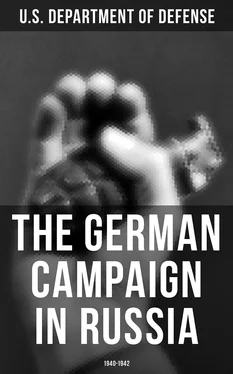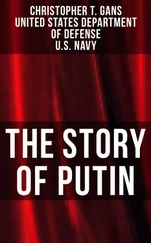During the Russian campaign, Force XXI will continue to consider the protection of Norway as its primary mission. Any excess forces available beyond the scope of this mission will be committed primarily in the north (mountain corps) to secure the Petsamo region and its ore mines as well as the highway connecting Petsamo with Oulu (Arctic Highway). Together with Finnish contingents these forces will subsequently thrust toward the Murmansk railway in an attempt to prevent supplies from- reaching the. Murmansk area by land.
Whether an operation by a stronger German force — consisting of two to three divisions which would jump off from the region around and south of Rovaniemi — can be executed, will depend on Sweden's willingness to make its railroads available for such a concentration of German units.
The bulk of the Finnish Army will coordinate its operations with the advance of the German north wing. Its principal missions will be to tie down the maximum Russian forces by an attack west of or on both sides of Lake Ladoga and to seize Hanko.
The army group committed south of the Pripyat Marshes will also attempt a double envelopment. Strong forces concentrated on both wings are to achieve the complete annihilation of the Russian troops in the Ukraine west of the Dnepr. The main attack will be directed from the Lublin area toward Kiev, while the forces concentrated in Romania will cross the lower Pruth River and form the other arm of a wide envelopment. The Romanian Army will have the mission of tying down the Russian forces which are to be caught between the two pincers.
Once the battles south and north of the Pripyat Marshes have been brought to a successful conclusion, pursuits will be launched with the following objectives:
In the south the Donets Basin, highly important from a military-economic point of view, must be seized without delay.
In the north Moscow must be reached as soon as possible. economic significance of capturing this city is tremendous. The political and Moreover, German possession of Moscow will deprive the enemy of the most important railway hub.
B. Air Force:
Its mission will be to paralyze and eliminate the Russian air force, and to support the Army's operations at the points of main effort, particularly in the Army Group Center area and along the north wing of Army Group South. According to their significance for the course of the campaign, the Russian railways will be severed by air attacks. In some instances most important railroad installations (river crossings!) will be seized by vertical envelopments performed by parachute and airborne troops.
In order to concentrate the entire striking power of the German Air Force on neutralizing the enemy air force and on providing direct support for the Army, the Russian armament industry will not be attacked during the initial phase of the campaign. Once the war of movement has come to a conclusion, such attacks might be considered, particularly against the industrial region in the Urals.
C. Navy:
In addition to defending the German coast, the Navy will have the mission of preventing the enemy naval forces from forcing their way out of the Baltic Sea. Once the Leningrad area has been seized, the Russian Baltic Fleet will have been deprived of all its bases. Since its situation will then be altogether hopeless, major naval engagements prior to that time must be avoided.
After the Russian fleet has been eliminated, it will be important to establish full-scale maritime traffic in the Baltic, including the logistical support of ground forces in the northern part of the Russian theater (mine sweeping!).
IV. All orders issued by the commanders in chief of the services on the basis of this directive are to be formulated in such a manner that they leave no doubt on the precautionary nature of these measures which are prepared for the event that Russia should change her present attitude toward us. The number of officers to be informed during the preliminary stage must be kept to aminimum. Additional personnel will be initiated as late as feasible, and then only to the extent necessary for the performance of their individual duties. This will minimize the risk of serious political and military consequences that might result from our preparations — for the implementation of which not even a deadline has been set — becoming known.
V. I request the commanders in chief of the services to report to me on their future plans which are to be based on this directive.
All services will submit to me progress reports on their projected preparations through the Armed Forces High Command.
ADOLF HITLER
The generally held opinion that the Russian campaign would be of short duration found its clearest expression in Section III B of Directive No. 21, pertaining to the Air Force. By giving the Luftwaffe primarily a ground-support mission and equipping it accordingly, Hitler and Goering expressed their belief that strategic bombing would be unnecessary. The Navy, however, did not anticipate the Russian campaign with so much optimism.
On 27 December Admiral Raeder tried once more to convince Hitler that Germany's most urgent task was to concentrate all its military power against Britain. That country was gaining strength as a result of the Italian reverses in the Mediterranean and the increasing support it received from the United States. On the other hand, Britain could be defeated if Germany turned its entire war potential to strengthening the Navy and Air Force. Any dissipation of strength would prolong the war and jeopardize the final success. In concluding, Raeder raised very strong objections against starting the Russian campaign before Britain was defeated.
In his reply Hitler agreed that greater stress would have to be placed on submarine construction. In general, however, he felt that the Soviet Union's expansionist policy in the Balkans made it mandatory that Germany eliminate its last opponent on the European continent before the final showdown with Britain. For this purpose, the Army would have to be built up first; as soon as the Russian campaign had been won, the needs of the Navy and Luftwaffe would have priority.
Chapter 2
Operational Planning
Table of Contents
The Army's Operation Order
(3 February 1941)
Table of Contents
During January 1941 each army group was informed of its mission as stipulated in Directive No. 21 and ordered to carry out intracommand map maneuvers for the purpose of studying the operation plan in detail and examining the proposed courses of action. A number of command post exercises took place at each army group headquarters, and the ideas formulated on these occasions were discussed in great detail during meetings of Army High Command and army group representatives.
At a conference that took place in Berlin on 31 January, Field Marshal von Brauchitsch told the commanding generals of the army groups that his plans were based on the assumption that the Russians would give battle west of the Dnepr-Dvina line. Later on, when one of the army group commanders asked Halder whether this assumption was supported by facts, the latter replied: "It might easily turn out different."
Some of the ideas expressed during the exercises and meetings were incorporated into the operation order, which was the Army High Command's implementation of Directive No. 21. The order originated from the Operations Division and was eventually signed by Field Marshal von Brauchitsch after Hitler approved it on 3 February. In the introductory part of the order it was stated that preparations for defeating the Soviet Union in a lightning campaign had to be made in the event that the USSR should change its attitude toward Germany. For this purpose armored wedges would have to be driven deep into western Russia and the bulk of the Red Army would have to be destroyed before it had a chance to withdraw.
Читать дальше












